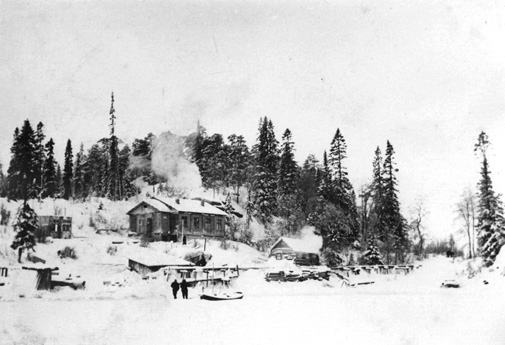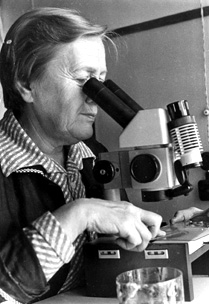
Best photo
click to see the fullsize image
Regular, day-to-day research at the White Sea is tightly linked with the activity of biological stations. At the White Sea, the first of them was the Solovetskaya Biological Station of the Saint-Petersburg Society of Naturalists, which however lasted for a short period only - from 1882 till 1899. In the XX century, several biological stations have been organized, three of which exist today: the White Sea Biological Station (WSBS) of the Zoological Institute of Russian Academy of Sciences, the Marine Biological Station of the St.-Petersburg State University and the White Sea Biological Station of the Moscow State University.
Our Station, the WSBS, was founded by the order of the Council of Ministers of the USSR in summer 1949. The initiator of the creation of the WSBS was Prof. Z.G. Palenichko, who became the first director of the Station. Scientific collections were carried out from spring to autumn from board of two vessels: “Ispytatel'” and since 1952 “Professor Mesyatsev”. The main areas of research included White Sea hydrology, species diversity, distribution and abundance of the White Sea organisms, and analysis of the marine food webs with a focus on fishes.
Despite the scientific success of these research trips, it was clear that the year-round monitoring studies were needed at the White Sea that could have been performed only from a stationary research location. In June 1957, a special commission led by Dr. A.N. Svetovidov performed a trip along the White Sea coasts and chose the Krivozerskaya Bay as a place for building the permanent research station. The bay is located close to the cape Kartesh at the mouth of the 30-km fjord-like Chupa Inlet in the Kandalaksha Bay. It was selected for several reasons including the presence of a deep sheltered harbour, considerable habitat diversity allowing collection of numerous algae and animal species, remoteness from industry and towns, and the presence of a deep clear lake as a source of drinking water. On July 17, 1957, the Presidium of Academy of Sciences of the USSR decreed to create the White Sea Biological Station at the new place and assigned it the following research directions:
1. study of biology and life cycles of major representatives of the White Sea flora and fauna and of their distinctions from the same species inhabiting the other seas;
2. study of seasonal, annual and long-term fluctuations and changes in abundance of the common White Sea species; 3. study of seasonal, annual and long-term fluctuations of living conditions of different groups of the White Sea organisms.
V.V. Kuznetsov was appointed as the Director of the WSBS. Unfortunately he soon resigned this position because of the illness that led to his death on June 6, 1961. One of the research vessels of the WSBS was named after Professor Vladimir Kuznetsov. Prof. Kuznetsov was succeeded by Prof. Z.G. Palenichko as the Director of the WSBS.
On July 19, 1957, two days after the decree that marked formation of the WSBS, the first hydrological measurements and plankton sampling was performed at a location near the WSBS (station D1 φ=66° 19'50" N, λ=33° 40'06" E). This date is considered as the second birthday of the WSBS. Monitoring of the White Sea pelagic ecosystems that started more than 50 years ago is still continued. During the warm part of the year, samples are taken from the board of a ship once in ten days, and in winter sampling is performed monthly from the ice surface.
In 1960s, comprehensive surveys were carried out in Onega and Kandalaksha Bays using research vessels belonging to the WSBS. These surveys significantly enlarged the lists of known species and revealed seasonal and long-term features of species distribution and abundance. In 1970-80s, the research programme of the WSBS has significantly expanded and diversified, the station has constructed a new laboratory building and several living houses and acquired three new research vessels “Kartesh”, “Ladoga” and “Onega”.

In 1978 Dr. Valentina G. Kulachkova became the Director of the WSBS, who was replaced by Professor Victor Ja. Berger in 1982. Under their leadership, applied research expanded in addition to the traditional fundamental research of the WSBS. The WSBS scientists developed, tested and applied the biotechnology of blue mussel cultivation that provided excellent productivity under the challenging conditions of this sub-Polar region, and developed and successfully implemented efficient technologies for recovery of severely decimated populations of the White Sea herring.
In the last decade several new research directions were added to the scientific repertoire of the WSBS, including ecological parasitology, experimental community ecology, and developmental biology of benthic invertebrates. Since 2008 the WSBS is led by Dr. Alexey Sukhotin.

The climate at the White Sea is continental with an average air temperature about −10°Ń in winter occasionally falling below −30°Ń, and an average air temperature of 15—18°Ń during the summer months. For about five months a year (December to May) the White Sea is covered with ice, all except its central parts. Summer surface water temperature is usually about 11−13°C, occasionally reaching 18°Ń, while in winter it is −0.3− −0.8°Ń. Below 120 m of depth, the water temperature is −1.2 — −1.6°Ń all year round.
The overall annual freshwater flow of numerous streams and rivers (Varzuga, Vyg, Kem’, Keret’, Kolvitsa, Kuloy, Mezen’, Niva, Onega, Ponoj, Severnaya Dvina, Umba, and others) is 230—240 km3. Salinity of surface waters is about 25 ppt, increasing with depth to 29—30 ppt. In winter accumulation of freshwater runoff under the ice may cause a significant decrease of surface salinity.
Tides are regular, semi-diurnal. Tidal current enters Voronka and Gorlo Straits causing significant water rise in these areas, reaching maximum (up to 9 m) in Mezen’ Bay. In other regions of the sea, the tidal height is 1.8—2 m.
The White Sea waters are well aerated. Dissolved oxygen concentration varies from 6 to 9 mg O2/l. Average level of dissolved organic matter is between 7 and 19 mg/l, while concentration of organic carbon in water column is 3.5—9.5 mg/l (average 6.0 mg/l). Chlorophyll is unevenly distributed and varies in photic layers from 0.5 mg/m3 (in Gorlo Straits) to 15.5 mg/m3 (in Dvina Bay).
The White Sea fauna and flora consists of Arctic and Arctic-Boreal species. Species diversity (in terms of the number of plant and animals species inhabiting the White Sea) is somewhat lower than in the adjacent Barents Sea but still is quite considerable including:
For more information about the White Sea read:
Our Station, the WSBS, was founded by the order of the Council of Ministers of the USSR in summer 1949. The initiator of the creation of the WSBS was Prof. Z.G. Palenichko, who became the first director of the Station. Scientific collections were carried out from spring to autumn from board of two vessels: “Ispytatel'” and since 1952 “Professor Mesyatsev”. The main areas of research included White Sea hydrology, species diversity, distribution and abundance of the White Sea organisms, and analysis of the marine food webs with a focus on fishes.

Building construction at the Station, 1957ă.
Despite the scientific success of these research trips, it was clear that the year-round monitoring studies were needed at the White Sea that could have been performed only from a stationary research location. In June 1957, a special commission led by Dr. A.N. Svetovidov performed a trip along the White Sea coasts and chose the Krivozerskaya Bay as a place for building the permanent research station. The bay is located close to the cape Kartesh at the mouth of the 30-km fjord-like Chupa Inlet in the Kandalaksha Bay. It was selected for several reasons including the presence of a deep sheltered harbour, considerable habitat diversity allowing collection of numerous algae and animal species, remoteness from industry and towns, and the presence of a deep clear lake as a source of drinking water. On July 17, 1957, the Presidium of Academy of Sciences of the USSR decreed to create the White Sea Biological Station at the new place and assigned it the following research directions:
1. study of biology and life cycles of major representatives of the White Sea flora and fauna and of their distinctions from the same species inhabiting the other seas;
2. study of seasonal, annual and long-term fluctuations and changes in abundance of the common White Sea species; 3. study of seasonal, annual and long-term fluctuations of living conditions of different groups of the White Sea organisms.

Prof. V.V.Kuznetsov
V.V. Kuznetsov was appointed as the Director of the WSBS. Unfortunately he soon resigned this position because of the illness that led to his death on June 6, 1961. One of the research vessels of the WSBS was named after Professor Vladimir Kuznetsov. Prof. Kuznetsov was succeeded by Prof. Z.G. Palenichko as the Director of the WSBS.
On July 19, 1957, two days after the decree that marked formation of the WSBS, the first hydrological measurements and plankton sampling was performed at a location near the WSBS (station D1 φ=66° 19'50" N, λ=33° 40'06" E). This date is considered as the second birthday of the WSBS. Monitoring of the White Sea pelagic ecosystems that started more than 50 years ago is still continued. During the warm part of the year, samples are taken from the board of a ship once in ten days, and in winter sampling is performed monthly from the ice surface.
In 1960s, comprehensive surveys were carried out in Onega and Kandalaksha Bays using research vessels belonging to the WSBS. These surveys significantly enlarged the lists of known species and revealed seasonal and long-term features of species distribution and abundance. In 1970-80s, the research programme of the WSBS has significantly expanded and diversified, the station has constructed a new laboratory building and several living houses and acquired three new research vessels “Kartesh”, “Ladoga” and “Onega”.

Building of a dormitory, 1971ă.
Long-term monitoring of benthic animals started, and life cycles of common White Sea invertebrates were described. The distribution and population dynamics of blue mussels Mytilus edulis were analysed. Ichthyologists of the WSBS investigated life cycles, migrations, feeding, as well as population structure and dynamics of fishes and their parasites. The ecophysiological research of adaptations to salinity and temperature and studies of bioluminescence of marine organism were developed led by Professor Vladislav V. Khlebovich, who became the Director of the WSBS in 1965. In 1968 the WSBS merged with the Zoological Institute and became one of its departments.

Dr. V.G.Kulachkova
In 1978 Dr. Valentina G. Kulachkova became the Director of the WSBS, who was replaced by Professor Victor Ja. Berger in 1982. Under their leadership, applied research expanded in addition to the traditional fundamental research of the WSBS. The WSBS scientists developed, tested and applied the biotechnology of blue mussel cultivation that provided excellent productivity under the challenging conditions of this sub-Polar region, and developed and successfully implemented efficient technologies for recovery of severely decimated populations of the White Sea herring.
In the last decade several new research directions were added to the scientific repertoire of the WSBS, including ecological parasitology, experimental community ecology, and developmental biology of benthic invertebrates. Since 2008 the WSBS is led by Dr. Alexey Sukhotin.

Map of the White Sea (enlarge)
The White Sea is located in the north-west of Russia and is a part of the Arctic Ocean deeply penetrating the continent and separated from the adjacent Barents Sea by bottom rise. The conventional northern border of the White Sea is a line connecting capes Kanin Nos and Svyatoj Nos. Average depth of the Sea is 60 m reaching down to 343 m in the deepest parts. Sea surface area is about 90,000 km2, and the volume is 5400 km3.
The climate at the White Sea is continental with an average air temperature about −10°Ń in winter occasionally falling below −30°Ń, and an average air temperature of 15—18°Ń during the summer months. For about five months a year (December to May) the White Sea is covered with ice, all except its central parts. Summer surface water temperature is usually about 11−13°C, occasionally reaching 18°Ń, while in winter it is −0.3− −0.8°Ń. Below 120 m of depth, the water temperature is −1.2 — −1.6°Ń all year round.
The overall annual freshwater flow of numerous streams and rivers (Varzuga, Vyg, Kem’, Keret’, Kolvitsa, Kuloy, Mezen’, Niva, Onega, Ponoj, Severnaya Dvina, Umba, and others) is 230—240 km3. Salinity of surface waters is about 25 ppt, increasing with depth to 29—30 ppt. In winter accumulation of freshwater runoff under the ice may cause a significant decrease of surface salinity.
Tides are regular, semi-diurnal. Tidal current enters Voronka and Gorlo Straits causing significant water rise in these areas, reaching maximum (up to 9 m) in Mezen’ Bay. In other regions of the sea, the tidal height is 1.8—2 m.
The White Sea waters are well aerated. Dissolved oxygen concentration varies from 6 to 9 mg O2/l. Average level of dissolved organic matter is between 7 and 19 mg/l, while concentration of organic carbon in water column is 3.5—9.5 mg/l (average 6.0 mg/l). Chlorophyll is unevenly distributed and varies in photic layers from 0.5 mg/m3 (in Gorlo Straits) to 15.5 mg/m3 (in Dvina Bay).
The White Sea fauna and flora consists of Arctic and Arctic-Boreal species. Species diversity (in terms of the number of plant and animals species inhabiting the White Sea) is somewhat lower than in the adjacent Barents Sea but still is quite considerable including:
| Group | # of species |
|---|---|
| Phytoplankton | 291 |
| Microphytobenthos | 750 |
| Macrophytobenthos | 185 |
| Zooplankton | 142 |
| Macrozoobenthos | 800 |
| Fish | 57 |
| Marine mammals | 5 |
For more information about the White Sea read:
- V.V. Kuznetsov. 1960. The White Sea and the Biological Peculiarities of Its Flora and Fauna. Academy of Sciences of the USSR Publishers, Moscow-Leningrad. (In Russian)
- The White Sea. 1995. V. Ja. Berger (Ed.) Exploration of the Fauna of the Seas, 42 (50). St.-Petersburg, Zoological Institute of Russian Academy of Sciences. (In Russian)
- White Sea. Ecology and Environment. 2001. Berger V., Dahle S., Galaktionov K., Kosobokova X., Naumov A., Rat’kova T., Savinov V., Savinova T. St.Petersburg-Tromsø: Derzavets Publishers.

